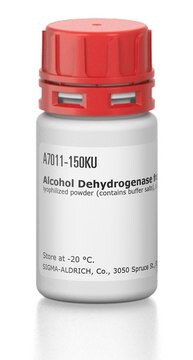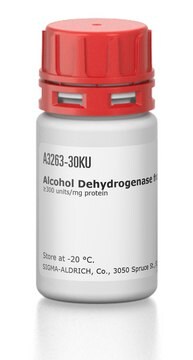F8649
Formate Dehydrogenase from Candida boidinii
lyophilized powder, 5.0-15.0 units/mg protein
Synonym(s):
FDH, Formate:NAD+ oxidoreductase
Sign Into View Organizational & Contract Pricing
All Photos(2)
About This Item
Recommended Products
biological source
fungus (Candida boidinii)
form
lyophilized powder
specific activity
5.0-15.0 units/mg protein
composition
Protein, 5.0-20.0% biuret
storage temp.
2-8°C
Looking for similar products? Visit Product Comparison Guide
Application
Formate Dehydrogenase (FDH) is used for diagnostics in large scale industrial processes. Its used in the production of an unnatural amino acid, tert-L-leucine, a component of some HIV protease and matrix metalloprotease inhibitors.
Biochem/physiol Actions
Formate dehydrogenase is an abundant enzyme from yeast Candida boidinii (CbFDH) that plays an important role in the energy supply of methylotrophic microorganisms and in the stress response of plants.
Formate dehydrogenase is involved in the stress response of plants and catalyzes the reduction of NAD+ to NADH.
Unit Definition
One unit will oxidize 1.0 μmole of formate to CO2 per min in the presence of β-NAD at pH 7.6 at 37 °C.
Signal Word
Danger
Hazard Statements
Precautionary Statements
Hazard Classifications
Resp. Sens. 1
Storage Class Code
11 - Combustible Solids
WGK
WGK 3
Flash Point(F)
Not applicable
Flash Point(C)
Not applicable
Personal Protective Equipment
dust mask type N95 (US), Eyeshields, Gloves
Certificates of Analysis (COA)
Search for Certificates of Analysis (COA) by entering the products Lot/Batch Number. Lot and Batch Numbers can be found on a product’s label following the words ‘Lot’ or ‘Batch’.
Already Own This Product?
Find documentation for the products that you have recently purchased in the Document Library.
Customers Also Viewed
Do reactive oxygen species or does oxygen itself confer obligate anaerobiosis? The case of Bacteroides thetaiotaomicron.
Khademian, et al.
Molecular Microbiology, 114, 333-347 (2021)
Held in police custody.
A Skelt
Nursing times, 84(4), 50-52 (1988-01-02)
C Vinals et al.
Biochemical and biophysical research communications, 192(1), 182-188 (1993-04-15)
We propose a multiple alignment of the sequence of formate dehydrogenase with the D-specific 2-hydroxy acid dehydrogenases family. Structurally conserved regions are predicted for those sequences corresponding to important regions of the catalytic and the coenzyme binding domains defined from
Samrat Dutta et al.
The journal of physical chemistry. B, 116(1), 542-548 (2011-12-01)
Functionally relevant femtosecond to picosecond dynamics in enzyme active sites can be difficult to measure because of a lack of spectroscopic probes that can be located in the active site without altering the behavior of the enzyme. We have developed
Dmitry K Nilov et al.
Journal of biomolecular structure & dynamics, 30(2), 170-179 (2012-06-19)
The formation of the reactive enzyme-substrate complex of formate dehydrogenase has been investigated by molecular dynamics techniques accounting for different conformational states of the enzyme. Simulations revealed that the transport of substrate to the active site through the substrate channel
Our team of scientists has experience in all areas of research including Life Science, Material Science, Chemical Synthesis, Chromatography, Analytical and many others.
Contact Technical Service











